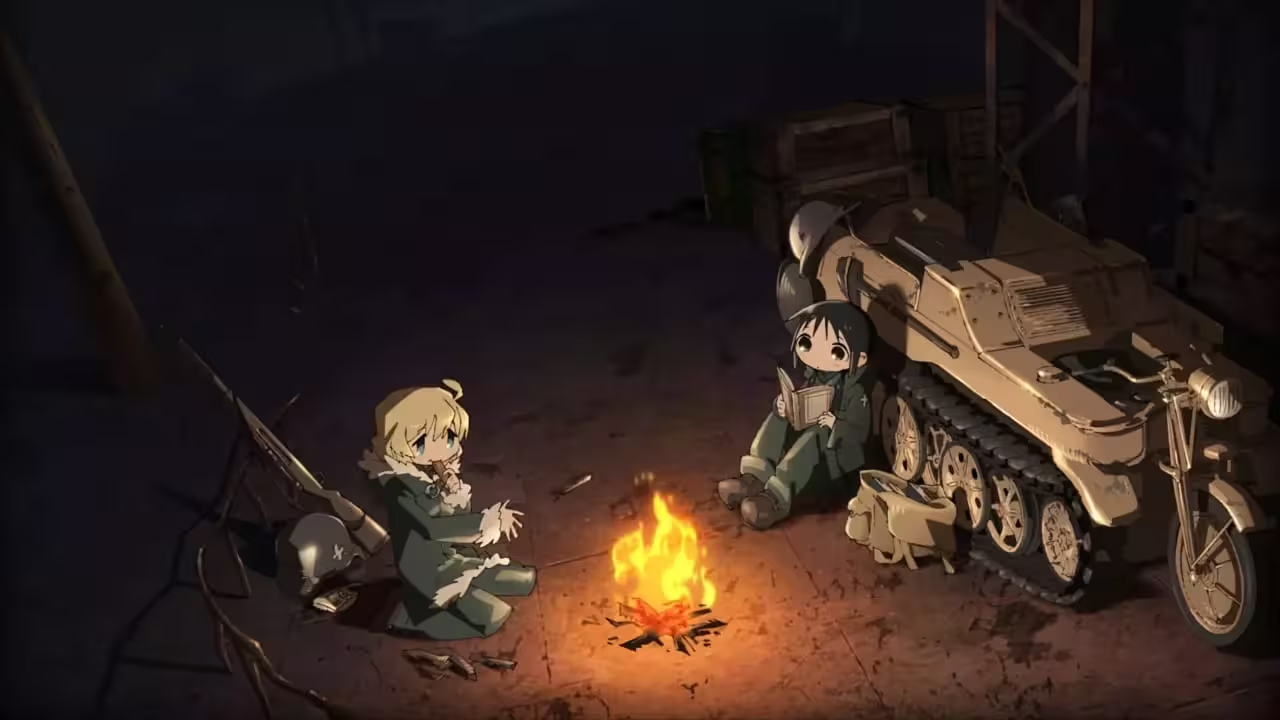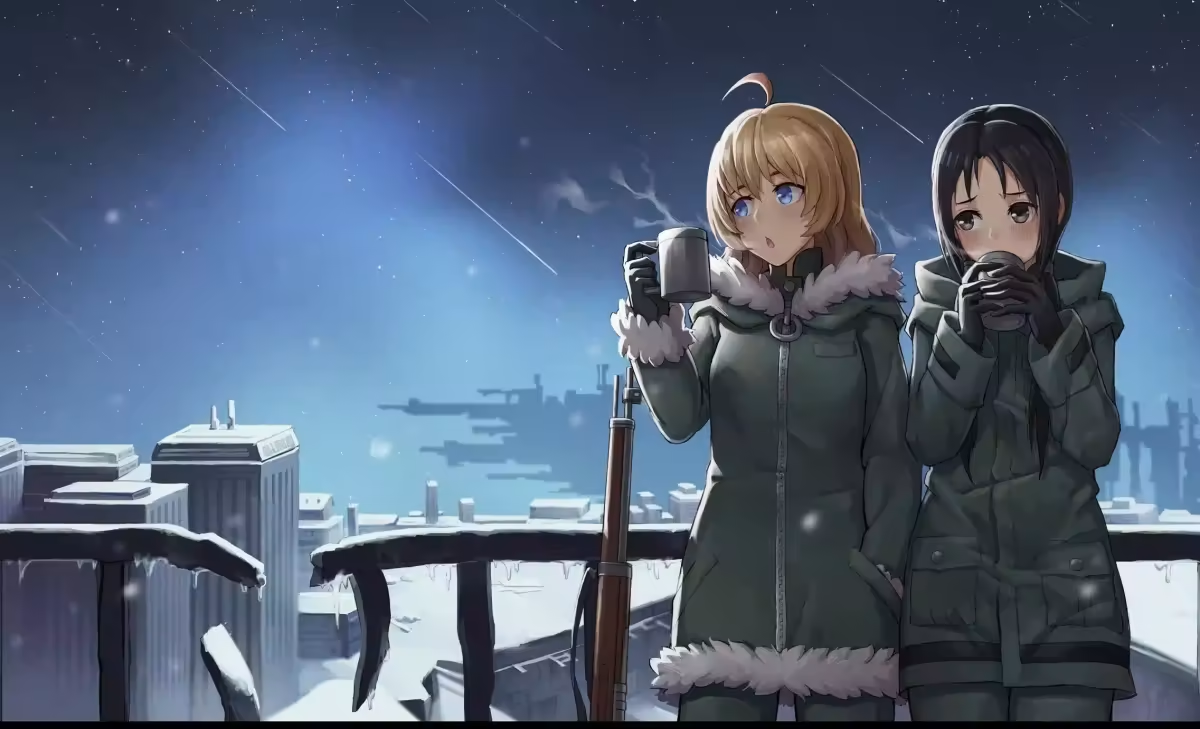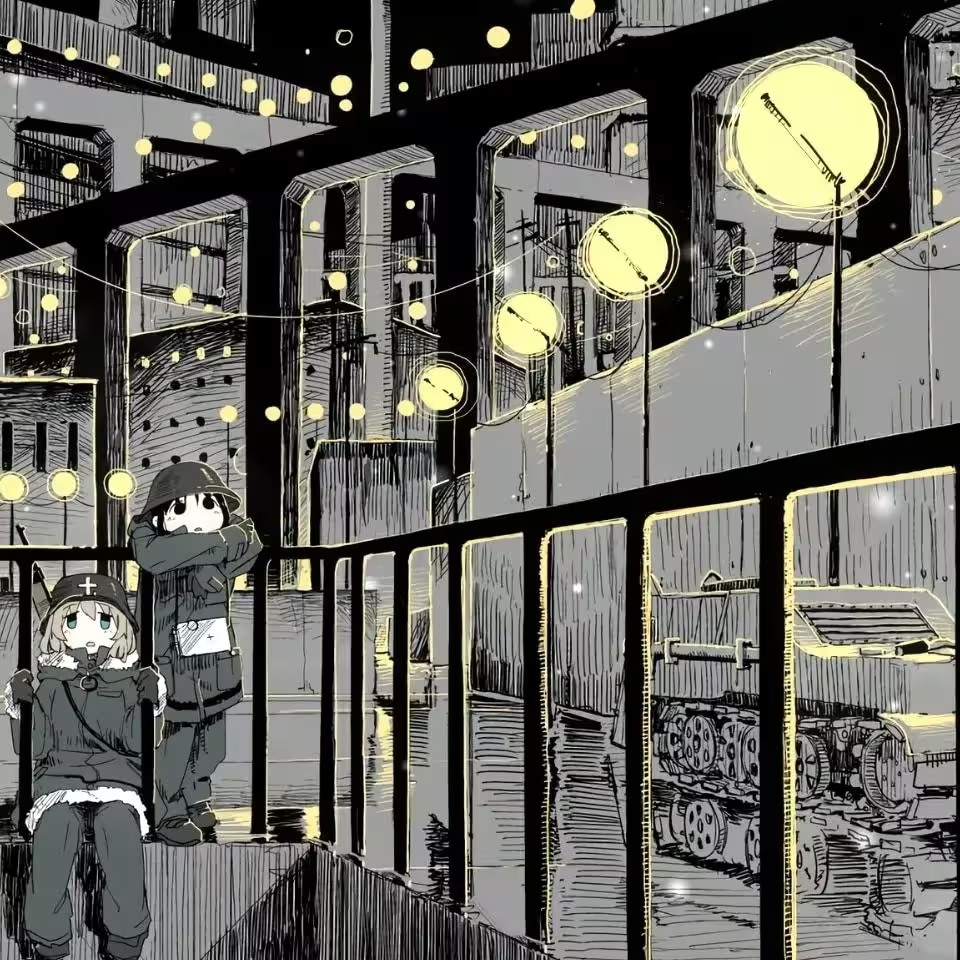The Unconventional Masterpiece of White Fox Studio
In the bustling landscape of Japanese animation, few works dare to slow down, shed plot conventions, and create space for reflection. Girls’ Last Tour (Shoujo Shuumatsu Ryokou), aired in 2017 and adapted from Tsukumizu’s manga, stands as one of these counter-current works. Produced by White Fox, it offers a minimalist post-apocalyptic road trip through the eyes of two girls wandering through world ruins.
Chito and Yuuri – The Last Humans in a Dead World
Chito and Yuuri, the only visible survivors of an unidentified cataclysm, traverse a world of concrete, metal and silence aboard their small tracked motorcycle. They aren’t truly seeking purpose; they survive, discover, and question. Each episode becomes a stop, a micro-adventure, an attempt to understand remnants of lost civilization.

Yin and Yang Character Dynamics
This duo functions as narrative yin and yang: Chito, calm and studious, reads books and seeks understanding. Yuuri, impulsive and carefree, lives in the moment and eats their rations. Their complementarity provides the anime’s emotional balance. Together, they form a tiny nucleus of humanity amidst the void.
Minimalist Visual Storytelling
The visual universe of Girls’ Last Tour is unique: gray and ochre tones, cyclopean architecture, desolate landscapes… yet never depressing. The characters’ soft, round designs create striking contrast with their environment, enhancing the journey’s strangeness. The animation, subtle but fluid, perfectly serves this narrative minimalism.
Kenichiro Suehiro’s Atmospheric Soundtrack
The soundtrack by Kenichiro Suehiro is a atmospheric gem. Unobtrusive yet impactful, it knows when to disappear and when to strike – particularly with the opening theme, simultaneously melancholic and upbeat, which alone summarizes the anime’s mood: warm sadness.

Fragmentary Philosophical Narratives
The storytelling remains deliberately fragmentary. Each episode focuses on a concept: water, photography, music, religion, flight… Far from classic narrative arcs, the anime offers human-scale reflections about existence. The question isn’t where Chito and Yuuri are going, but what they’re becoming.
The Dance Scene – Beauty at World’s End
One most memorable scenes shows them discovering an old music recorder. Yuuri, fascinated, dances clumsily while Chito smiles silently. This fleeting moment encapsulates the work: even at oblivion’s edge, humans seek beauty. When all seems ended, a song, laugh or dance can still emerge.
Political Undertones Without Judgment
Girls’ Last Tour carries broad political dimensions. It questions legacy, memory, and destruction wrought by technology and war. Yet it never judges. It shows with restraint and simplicity. And it’s children – the last survivors – who rediscover what adults destroyed.

Tarkovskian and Saint-Exupéry Influences
In this regard, the anime recalls works by Tarkovsky or The Little Prince. Philosophical questioning permeates every word exchanged between Chito and Yuuri, every frame contains void – but void that nourishes thought.
The Power of Silence and Empty Spaces
Rarely has such a quiet anime said so much. No villains, no battles, no ultimate revelations. Just two girls, a ruined world, and slow progression toward uncertain elsewhere. Yet emotion surfaces – deep, sincere.
Cult Status and Lasting Legacy
Girls’ Last Tour’s cultural impact remained confined to enthusiast circles. It never achieved deserved commercial success. Yet it circulates like a well-kept secret, passed between connoisseurs of beautiful things.
An Anime Not For Everyone – But Essential For Some
This isn’t anime for all. It demands patience, contemplation, attention. But for those accepting this pact, it offers something rare: poetry of daily life in a forgotten world. A pure perspective on what being alive means.

GIRLS LAST TOUR – A Philosophical Journey Through Post-Apocalyptic Silence
Table of Contents
The Unconventional Masterpiece of White Fox Studio
In the bustling landscape of Japanese animation, few works dare to slow down, shed plot conventions, and create space for reflection. Girls’ Last Tour (Shoujo Shuumatsu Ryokou), aired in 2017 and adapted from Tsukumizu’s manga, stands as one of these counter-current works. Produced by White Fox, it offers a minimalist post-apocalyptic road trip through the eyes of two girls wandering through world ruins.
Chito and Yuuri – The Last Humans in a Dead World
Chito and Yuuri, the only visible survivors of an unidentified cataclysm, traverse a world of concrete, metal and silence aboard their small tracked motorcycle. They aren’t truly seeking purpose; they survive, discover, and question. Each episode becomes a stop, a micro-adventure, an attempt to understand remnants of lost civilization.
Yin and Yang Character Dynamics
This duo functions as narrative yin and yang: Chito, calm and studious, reads books and seeks understanding. Yuuri, impulsive and carefree, lives in the moment and eats their rations. Their complementarity provides the anime’s emotional balance. Together, they form a tiny nucleus of humanity amidst the void.
Minimalist Visual Storytelling
The visual universe of Girls’ Last Tour is unique: gray and ochre tones, cyclopean architecture, desolate landscapes… yet never depressing. The characters’ soft, round designs create striking contrast with their environment, enhancing the journey’s strangeness. The animation, subtle but fluid, perfectly serves this narrative minimalism.
Kenichiro Suehiro’s Atmospheric Soundtrack
The soundtrack by Kenichiro Suehiro is a atmospheric gem. Unobtrusive yet impactful, it knows when to disappear and when to strike – particularly with the opening theme, simultaneously melancholic and upbeat, which alone summarizes the anime’s mood: warm sadness.
Fragmentary Philosophical Narratives
The storytelling remains deliberately fragmentary. Each episode focuses on a concept: water, photography, music, religion, flight… Far from classic narrative arcs, the anime offers human-scale reflections about existence. The question isn’t where Chito and Yuuri are going, but what they’re becoming.
The Dance Scene – Beauty at World’s End
One most memorable scenes shows them discovering an old music recorder. Yuuri, fascinated, dances clumsily while Chito smiles silently. This fleeting moment encapsulates the work: even at oblivion’s edge, humans seek beauty. When all seems ended, a song, laugh or dance can still emerge.
Political Undertones Without Judgment
Girls’ Last Tour carries broad political dimensions. It questions legacy, memory, and destruction wrought by technology and war. Yet it never judges. It shows with restraint and simplicity. And it’s children – the last survivors – who rediscover what adults destroyed.
Tarkovskian and Saint-Exupéry Influences
In this regard, the anime recalls works by Tarkovsky or The Little Prince. Philosophical questioning permeates every word exchanged between Chito and Yuuri, every frame contains void – but void that nourishes thought.
The Power of Silence and Empty Spaces
Rarely has such a quiet anime said so much. No villains, no battles, no ultimate revelations. Just two girls, a ruined world, and slow progression toward uncertain elsewhere. Yet emotion surfaces – deep, sincere.
Cult Status and Lasting Legacy
Girls’ Last Tour’s cultural impact remained confined to enthusiast circles. It never achieved deserved commercial success. Yet it circulates like a well-kept secret, passed between connoisseurs of beautiful things.
An Anime Not For Everyone – But Essential For Some
This isn’t anime for all. It demands patience, contemplation, attention. But for those accepting this pact, it offers something rare: poetry of daily life in a forgotten world. A pure perspective on what being alive means.